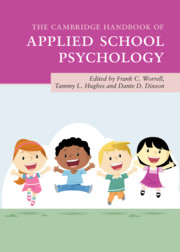Book contents
- The Cambridge Handbook of Applied School Psychology
- The Cambridge Handbook of Applied School Psychology
- Copyright page
- Contents
- Contributors
- Contributor Biographies
- Acknowledgments
- 1 Broadening the Focus of School Psychology Practice
- Part I Individual-Level Academic Interventions
- Part II Teacher- and System-Level Interventions
- Part III Interventions from Educational and Social/Personality Psychology
- Part IV Behavioral and Social-Emotional Interventions
- Part V Health and Pediatric Interventions
- Part VI Family Connections and Life Transitions
- Part VII Special Populations
- Part VIII Conclusion
- Index
- References
1 - Broadening the Focus of School Psychology Practice
Published online by Cambridge University Press: 18 September 2020
- The Cambridge Handbook of Applied School Psychology
- The Cambridge Handbook of Applied School Psychology
- Copyright page
- Contents
- Contributors
- Contributor Biographies
- Acknowledgments
- 1 Broadening the Focus of School Psychology Practice
- Part I Individual-Level Academic Interventions
- Part II Teacher- and System-Level Interventions
- Part III Interventions from Educational and Social/Personality Psychology
- Part IV Behavioral and Social-Emotional Interventions
- Part V Health and Pediatric Interventions
- Part VI Family Connections and Life Transitions
- Part VII Special Populations
- Part VIII Conclusion
- Index
- References
Summary
School psychology fills a unique and important niche in education. Falling at the intersection of learning, academic achievement, and behavioral, emotional, and social well-being, school psychology plays a role in helping students, families, educators, and school systems meet the goals of a free and appropriate education for all youth, with or without a special education classification. In this chapter, we briefly review the purpose of education and discuss the groups that are not well served by education. We then provide an overview of the chapters that make up this text, including those on the important recent contributions to education and schooling from social psychology.
Keywords
- Type
- Chapter
- Information
- Publisher: Cambridge University PressPrint publication year: 2020



